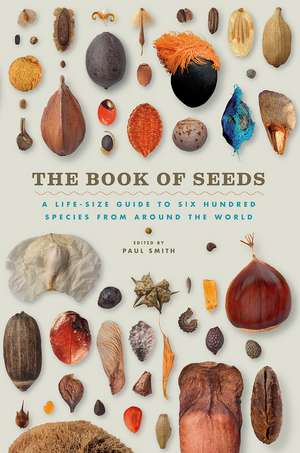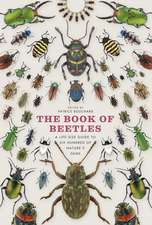The Book of Seeds: A Life-Size Guide to Six Hundred Species from around the World
Editat de Paul Smithen Limba Engleză Hardback – 19 feb 2018
Seeds are nature’s consummate survivors. The next time you admire a field of waving green grassland or a stunning grove of acacia, stop to consider how it got that way—often against incredible odds. Seeds can survive freezing temperatures and drought. They can pass through our digestive systems without damage and weather a trip across the ocean, hitching a ride on marine debris. They can even endure complete desiccation, a feat taken to extraordinary lengths by the date palm, a seed from which was recovered from the palace of Herod the Great was germinated after some two thousand years.
The Book of Seeds takes readers through six hundred of the world’s seed species, revealing their extraordinary beauty and rich diversity. Each page pairs a beautifully composed photo of a seed—life-size, and, in some cases, enlarged to display fine detail—with a short description, a map showing distribution, and information on conservation status. The whole spectrum of seeds is covered here. There are prolific species like corn and less widely distributed species, like the brilliant blue seeds of the traveler’s palm or the bird of paradise flower, aptly named for its distinctive orange coiffure. There are tiny seeds and seeds weighing up to forty pounds. And while seeds in all their shapes, sizes, and colors grant us sustenance, there are even some we would be wise to treat with caution, such as the rosary pea, whose seeds are considered more toxic than ricin.
The essential guide to these complex plant creations, The Book of Seeds offers readers a rare, up-close look that will inspire scientists and nature lovers alike.
The Book of Seeds takes readers through six hundred of the world’s seed species, revealing their extraordinary beauty and rich diversity. Each page pairs a beautifully composed photo of a seed—life-size, and, in some cases, enlarged to display fine detail—with a short description, a map showing distribution, and information on conservation status. The whole spectrum of seeds is covered here. There are prolific species like corn and less widely distributed species, like the brilliant blue seeds of the traveler’s palm or the bird of paradise flower, aptly named for its distinctive orange coiffure. There are tiny seeds and seeds weighing up to forty pounds. And while seeds in all their shapes, sizes, and colors grant us sustenance, there are even some we would be wise to treat with caution, such as the rosary pea, whose seeds are considered more toxic than ricin.
The essential guide to these complex plant creations, The Book of Seeds offers readers a rare, up-close look that will inspire scientists and nature lovers alike.
Preț: 395.69 lei
Nou
Puncte Express: 594
Preț estimativ în valută:
75.71€ • 79.26$ • 62.65£
75.71€ • 79.26$ • 62.65£
Carte disponibilă
Livrare economică 15-29 martie
Preluare comenzi: 021 569.72.76
Specificații
ISBN-13: 9780226362236
ISBN-10: 022636223X
Pagini: 656
Ilustrații: 600 color plates, 600 line drawings
Dimensiuni: 178 x 267 x 48 mm
Greutate: 2.31 kg
Ediția:First Edition
Editura: University of Chicago Press
Colecția University of Chicago Press
ISBN-10: 022636223X
Pagini: 656
Ilustrații: 600 color plates, 600 line drawings
Dimensiuni: 178 x 267 x 48 mm
Greutate: 2.31 kg
Ediția:First Edition
Editura: University of Chicago Press
Colecția University of Chicago Press
Notă biografică
Paul Smith is secretary general of Botanic Gardens Conservation International, a nonprofit organization that promotes plant conservation in botanic gardens. He is a former head of the Millennium Seed Bank at the Royal Botanic Gardens, Kew, the largest and most diverse seed bank in the world.
Cuprins
Introduction
What is a seed?
How did seed plants evolve?
Seeds & humans
Seed conservation
Plant diversity & why it matters
Seed-bearing plants
CYCADOPHYTA
GINKOPHYTA & GNETOPHYTA
PINOPHYTA
MAGNOLIOPHYTA
Appendices
Glossary
Resources
Index of common names
Index of Latin names
Acknowledgments
What is a seed?
How did seed plants evolve?
Seeds & humans
Seed conservation
Plant diversity & why it matters
Seed-bearing plants
CYCADOPHYTA
GINKOPHYTA & GNETOPHYTA
PINOPHYTA
MAGNOLIOPHYTA
Appendices
Glossary
Resources
Index of common names
Index of Latin names
Acknowledgments
Recenzii
“Handsome and handy. . . . Learn here about achenes like rhubarb seeds, which are dispersed by the wind. Or samaras, like the seeds of the English elm, found in the middle of two transparent green wings.”
"A well-written primer on seed anatomy, evolution, and use, including conservation. . . . It will be useful to both the professional botanist and amateur, as well as anyone curious about how nature looks and works."



